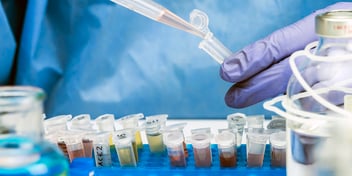Wastewater surveillance system put to use against COVID-19
Australian researchers have achieved initial success in developing a surveillance system to track outbreaks of COVID-19 using raw sewage samples collected from wastewater treatment plants.
Led by the University of Queensland (UQ) and CSIRO, the study was successful in detecting the novel coronavirus gene SARS-CoV-2 in raw sewage.
CSIRO Land and Water Science Director Dr Paul Bertsch said the capability to detect the virus in wastewater treatment plants offers substantial benefits and options in terms of how to manage the pandemic in Australia.
“It's a powerful surveillance tool. As we start easing restrictions on social distancing, through to when we begin to open our borders, this kind of surveillance tool will be important to guide decisions and communications by public health authorities,” he said.
“It could be an important additional tool to enable the economy to start back up, while also ensuring the protection of public health.
“Understanding in advance where outbreaks may be emerging is critical information for managing public health interventions.”
The sampling methodology of wastewater treatment plants uses UQ’s national work, which samples wastewater to trace illicit drug use in regions around Australia. Similarly to past studies, the identity of wastewater treatment plants involved in the research are to remain anonymous.
Directing resources
Further to identifying ‘hot spot’ communities, Bertsch said the data delivers huge benefits in terms of how to make decisions and manage resources moving forward.
“We're doing really well here in Australia, but one of the issues with testing in many countries where test kits may be limited is not knowing the best time to test,” he said.
“But this kind of surveillance would allow for health professionals to make decisions much more systematically. If wastewater surveillance provides an early warning of an emerging hot spot, test kits could be deployed to get a higher proportion of people in the population tested.
“One of the big challenges with SARS-CoV-2 is that a large proportion of individuals that are infected are asymptomatic. This technique works for both individuals expressing symptoms as well as asymptomatic patients.”
Bertsch said the approach has been used internationally to help identify the presence of disease and that the approach offers a means of testing for vulnerable communities.
“Israel has been testing wastewater routinely for decades, so the concept itself isn't new. They're looking for things like hepatitis, polio virus and norovirus for community health protection,” he said.
"The data will be particularly useful for catchments with vulnerable populations where testing using other methods may not be feasible.”
Systematic sampling
Director of UQ’s Queensland Alliance for Environmental Health Sciences Professor Kevin Thomas said the research used systematic sampling and analysis of wastewater using a standardised, coordinated approach based on refined analytical methods.
"The wastewater samples were analysed for specific nucleic acid fragments of the virus using RT-PCR analysis, which is used to identify a gene fragment from SARS-CoV-2," he said.
"The presence of SARS-CoV-2 in specific wastewater samples was then confirmed using sequencing techniques.
"By showing how the method has worked in Australia, it is hoped that this research will bring together a national collaboration of government authorities, wastewater utilities, universities and other research organisations and commercial laboratories.
"The next step is to build the capacity to deliver a national program."
CSIRO Chief Executive Dr Larry Marshall said the testing offers Australia extra strength for managing COVID-19 within its borders.
"The hope is eventually we will be able to not just detect the geographic regions where COVID-19 is present, but the approximate number of people infected – without testing every individual in a location,” he said.
“This will give the public a better sense of how well we are containing this pandemic.”
A powerful tool
Water Research Australia (WaterRA) is also working on a program to track and monitor the presence of SARS-CoV-2 in the Australian sewerage network.
Dubbed the ColoSSoS Project (Collaboration on Sewage Surveillance of SARS-COV-2), the Australia-wide initiative aims to integrate reliable results of sewage testing for the SARS-CoV-2 virus with health data for COVID-19.
Involving experts in health, microbiology, laboratory testing, wastewater-based epidemiology and policy communication, the project is a major collaborative effort across water utilities, health departments and researchers.
Project Manager Dr Dan Deere said ColoSSoS aims to provide a powerful tool for decision-makers.
“The data it generates will potentially reveal cases in areas previously thought to be free from COVID-19; identify the extent of asymptomatic infections within communities; better characterise trends, peak infections and the persistence or re-emergence of disease; and verify whether COVID-19 has been eradicated in local populations,” he said.

